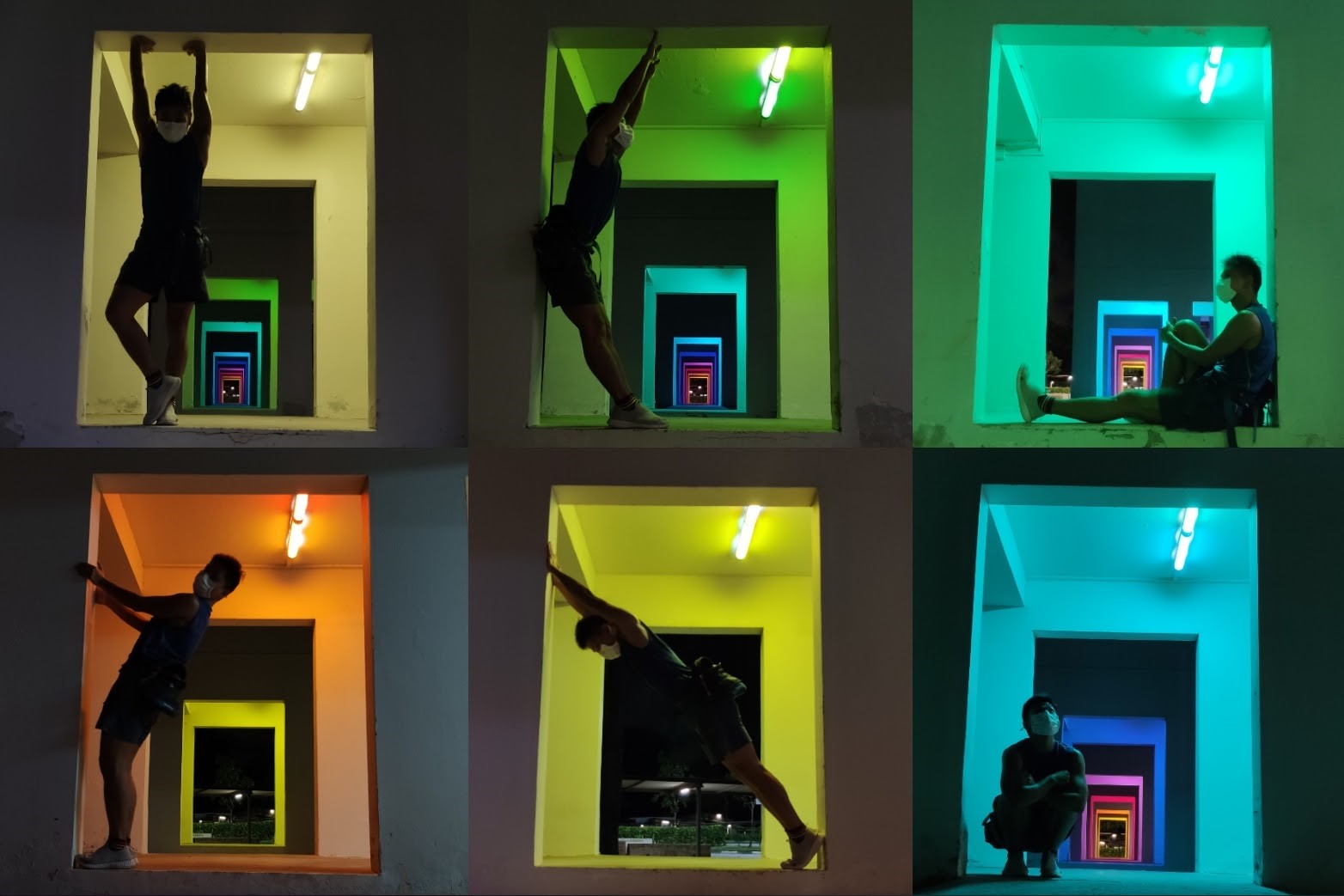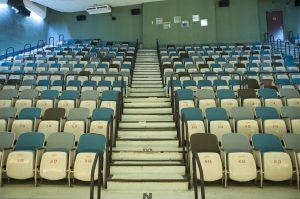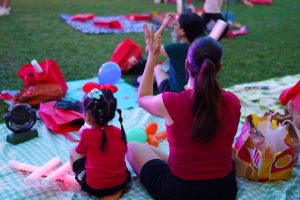All images by Yulianna Frederika for RICE Media and courtesy of Very Small Exhibition.
Wei Lieh Lee starts off his speech with a giant double-decker bus projected on a screen to his right. “When I was young, I always dreamt that one day I would become a bus driver. There’s just something about driving this gigantic vehicle, and ferrying people from one place to another place—it makes me feel that I’m a wonderful, useful person to society.”
It’s 2016, at a TEDx Conference held in Khoo Teck Phuat Hospital Auditorium. Behind him is a podium with a mic, but Wei has chosen to stand on the actual stage, closer to the audience.
ADVERTISEMENT
As I did my research on Wei Lieh—our meeting was in a few days—I couldn’t help but feel intrigued. Sure, we’ve all had quirky ambitions when we were younger. As a kid, I looked up highly to my dad as my role model. He worked as a manager then. Not that I knew what it meant, but I would go around telling people that I wanted to be one when I grew up.
Still, there wasn’t much I knew about Wei, except that he was an installation artist responsible for some HDB rainbow light installations that would pop up every now and then. But from his opening line at the TEDx Conference, I could already sense the kind of person Wei Lieh was—someone who wanted to be of service to others, perhaps in the most interesting of ways.
Before our meeting
“Wei threw a self-initiated farewell party that he invited us, students, to join. I remember it like it was just yesterday,” recalled Yulianna, our Digital Content Creator at RICE.
Some years back, Wei Lieh was Yulianna’s lecturer at Temasek Polytechnic’s Design School. In a way, it was a happy coincidence. Wei’s work as an installation artist was sent to me by my editor, with a simple task: to find out more. What was the inspiration behind his work? What was the rationale behind putting up rainbow lights for merely hours at a time?
So when I found out that a colleague knew Wei Lieh, I was nothing short of relieved. “Not many people would throw their own farewell party, but it was characteristic of Wei to want to invite everyone to have some fun.”
Wei has a natural ability to bring people together, Yulianna shared. Even seniors who had graduated came back to school just to join the party. The students played glow-in-the-dark pong, wore glow-in-the-dark bracelets and made art with simple materials like markers and strings.
Looking back, Yulianna felt intrigued by how simple activities like these became extra fun simply because they were made to be glow-in-the-dark. “I feel like this is something only Wei can pull off—bringing fun to ordinary things. He also had glow-in-the-dark stones that we could take home as door gifts, and to this day, I still have it with me on my desk.”
At a carpark rooftop in Clementi
Yulianna and I met up with Wei Lieh to follow him on an iteration of his ongoing project titled Very Momentary Exhibition. It was a pop-up installation where Wei would put up displays of rainbow lights on HDB blocks for only a few hours at a time.
We met at a non-descript HDB estate, situated in Clementi Avenue 4. I immediately recognised Wei, who came dressed in a pair of overalls, a bright red shirt, and sandals. He carried with him a small knapsack, a shopper bag full of his project materials, and a portable stepladder. Wei was pleasant, approachable, and as I would later learn, a little wacky.
“I’ve been meaning to do a tall building for a while now,” Wei remarked, gesturing to a Block 312A in our periphery. The building towered above us—we were only on the seventh floor, but the block he was about to transform was forty storeys high. Evidently, Wei had his work cut out for him. Suffice to say, I felt a little in awe of his dedication.
ADVERTISEMENT
His work on the Very Momentary Exhibition aims to involve the community and encourage interactions amongst strangers, whether it be going into the location to experience the lights, or taking pictures from afar. Wei Lieh hopes that the public can be a part of the piece, thus his decision to put up his installations on existing infrastructure in the heartlands. It serves as a chance to impact the everyday people who might come across the installation.
What led him here?
Before he became a full-time installation artist, Wei Lieh held a variety of titles: an international student, an art director, and an educator. When the pandemic hit, leading to a lot of unprecedented changes, it presented the perfect opportunity for Wei to explore his own interests.
“Becoming an installation artist was a deliberate choice this year because of the pandemic. Before this, I was working with an agency, but a lot of my responsibilities shifted in light of the pandemic,” Wei recalled. “I thought maybe it was time to take a break and focus on something I’ve always wanted to try, which was to see how things pan out as a full-time artist.”
Wei Lieh gave himself an entire year to explore and to create as many works as he could. Although he was in the creative industry, he didn’t have enough time for his personal pursuits though he always kept his ideas in his back pocket.
“When I worked as an art director or as a lecturer, those were linear paths. I could easily see how they would evolve as I progressed in my career,” Wei stated. “But, there’s one other path, which is fine arts. I’m really curious to see how it could go.”
On uncertainty of being an artist
“Do you ever worry about job stability?” I asked.
ADVERTISEMENT
He pauses for a moment. “I’m not sure if worry is the right way to put it.”
“Maybe it’s more of… feeling uncertain. There’s definitely a sense of uncertainty with how it will pan out, but then at the same time, I do see some possibility, that’s why I decided to go for it.” Wei said.
Wei Lieh shares that he faces a constant struggle in his work. As a creative, his sole wish is to focus on the conceptualisation and execution of his artwork. Throw money and practicality into the mix and conflict starts to surface. Although I wasn’t a fine artist by any means, I could empathize with Wei’s struggle in finding a balance between what he wanted to do and perhaps what he had to do out of necessity.
“It’s strange. Before that, as an art director, when people commission me for my work, I know every hour counts,” he laments. “Now, when it comes to my art, my intention when creating them—even for installations like Very Momentary Exhibition—is never to just sell.”
“My exhibitions are things I feel are worth doing. I want to create an experience for anyone who happens to engage with my piece. If it comes from somewhere like that, and you ask me to try and put a price tag on it, it’s very difficult,” said Wei.
Wei Lieh has made it a goal for his creative pursuits to become profitable within the next year. One such project he has slated is Bring LOVE Everywhere, a touring exhibition where he will push a lit-up “LOVE” sculpture by foot across Singapore. Wei shares that he has been actively sending out pitches to potential sponsors for this project.
However, the prospect of monetizing his work presents a paradox. “If I spend the whole of 2022 trying to think about how to make money out of my art pieces…,” he trails off.
“Then, that’s not what I want to do. The time that I spend figuring out how to sell my artwork, I should be using to create more. That’s the struggle.”
Wei has since recruited an artist manager who helps ease the burden of the monetary and administrative aspects of his work. This affords him more space to prioritise his creative process.
Wei is grateful to have someone to keep him in check. “I’m not a business person. I know what I need to do to run a business, but I’m just not someone who can do it or has the heart to do it because the money just isn’t my motivation in life.”
Opting out of the rat race
“That’s interesting,” I responded. “I think it’s a unique perspective to have in Singapore because everybody seems to be so focused on achieving material wealth.
The installation artist nods. “Let’s put it this way: my life motivation is to be a good person. Earning money doesn’t make me feel that I’m a good person, but, creating something meaningful for others to experience makes me feel better.”
He posits that he is not someone who lives a lavish lifestyle–in fact, he thinks that he does not require much in comparison to a lot of other people of the same age.
As Wei Lieh tells me this, I can’t help but think of how everyone in Singapore seems to be obsessed with the “five Cs”. I recall my previous conversation with Kathy Lee, an ex-lawyer who left her corporate career behind to open a pole dancing studio. Their decision to stray off the beaten path was inspiring to me, partly because as someone who is just starting out in the workforce, I’m still trying to find my way as well.
“Not to say that I’m better,” he chuckles. “It’s just that I don’t have the same kind of responsibilities. I have my parents to care for, but I’m not married, I don’t have kids. Others have different priorities, so that will be their focus.”
Wei also attributes his adaptability to his travels overseas. “It helped me to see a lot of different possibilities. I think in Singapore, people think there’s only one possibility in life. I think a lot of people have ideas, but they just don’t know whether it can work or not.”
A one-way ticket to New York
“When I was 26 years old, I made the biggest gamble of my life,” he explained. “I thought that maybe I should become a teacher, inspire the new generation to be who they really want and make a change in the world.”
To fulfil this goal, Wei Lieh decided that he first needed to grow and gain life experiences far away from home–so he decided to get his Bachelor’s Degree in New York City. It wasn’t easy–in fact when Wei first came to New York, he only had enough money to sustain him for a year.
As a result, Wei had to work hard, taking up part-time jobs and squeezing his budget just to make ends meet. He eventually landed a scholarship in his final year. “The situation helped me realise that any problem is just something to solve, not an obstacle. That plays into why I can just drop everything right now and then move into something so uncertain.”
The idea behind ‘Very Small Exhibition’ was conceived while he was in New York, together with friends Andrew Lim and Joanne Lim. Now, Wei is pursuing the entire creative project alone. “We first came up with this space, because with Singapore being such an expensive place to live, there weren’t many places where people can just go to be creative,” he shared.
A good designer needs to be highly aware of their surroundings, he states. A good designer should stay informed and should collect as many life experiences as possible. You have to learn all kinds of things that Singapore, being such a small place, cannot offer you.
“The most important thing is that you must always come back, bring all the knowledge that you have gained, and use that to make home a better place.”
The meaning behind the art
We wrapped up the interview and headed to the HDB block where the installation would be, taking a few photos along the way. While Yulianna takes portraits of Wei, the artist pulls out a multitude of concepts—such as a jump-shot and posing next to a bin, which gave us all a good laugh.
At the HDB stairwell, Wei meticulously begins work on his temporary installation, floor by floor, light tube by light tube. The rainbow light effect is created by pasting cellophane sheets over the LED lights. He only uses a few shades of cellophane rather than the whole colour spectrum. To achieve different colour tones, he pastes individual coloured sheets together such as blue and pink to make purple.
When I asked him whether he had a permit to put up his installation, he laughed. “In Singapore, everywhere need permit one.”
“As long as I don’t disturb anyone, I don’t endanger myself, and I don’t damage public property, then I won’t get any complaints.”
There were instances where residents were concerned about the safety of his projects. Once, an elderly man came up to him and told him that it was dangerous to darken the lights in the common walkways. Wei Lieh understood this, and allayed his concern by telling him that it’s only temporary, and at most for a few hours.
There were also other times where people would walk past and comment, “Eh, very nice!”
“It’s comments like those that make me feel that it’s worth it. It shows that it did impact people’s lives a little bit. When they walk past and you make them feel a little happier. I think that’s what these pieces are really for.”
Making an impact, one LED light at a time
By the time we wrapped up our session nearly half an hour later, we were three floors down. Throughout the whole process, Wei worked swiftly and in silence, determined to complete his installation within a stipulated time frame.
Yulianna and I bid our goodbyes, thanking Wei for his time. “He approaches everything with genuine and pure intentions,” Yulianna remarks. “That’s a trait of people that I cannot easily find in Singapore.”
I came to interview Wei Lieh fully expecting a deep meaning behind his installation, pondering on what the rainbow lights could possibly represent.
Instead, the story I got was one of a man who just wanted to be of service to others, who seemed to just want to jolt the mundanity of life we have here in Singapore. For me, it was more that I could bargain for.
It’s not about the craziest or most garish installation all the time. Sometimes all it takes is something as simple as rainbow lights at an HDB stairwell, for art to have a truly profound impact on our lives.







